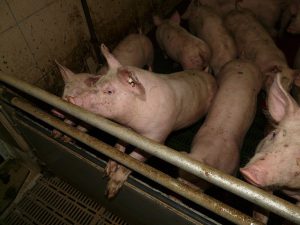With pig carcasses floating down the Huangpu and a new outbreak of bird flu, attention is being focused on Shaoxing. The city is the major pig-farming centre for eastern China, raising 7 million pigs a year. It also lies upstream of Shanghai’s Huangpu River.
Seven million pigs means, even at normal death rates, substantial numbers of dead pigs to dispose of. A ring of illegal traders who used to buy up and sell on the carcasses have been arrested and given life sentences, meaning dead pigs are now more likely just to be dumped.
Are Shaoxing’s problems symptomatic of a larger problem with Chinese animal health?
Jia Youling is head of the Chinese Veterinary Medical Association and formerly head of the Ministry of Agriculture’s Bureau of Veterinary Medicine. He says that, in the case of an epidemic, dead animals should be incinerated or buried in deep graves, to prevent the spread of disease. But there are problems: “Burial can present a risk to water sources and the soil, and incineration is expensive.”
Unlike in the south, which is criss-crossed by a network of rivers, pig farmers in the north are more likely to bury their deceased pigs. One farmer in Shaanxi told chinadialogue that after his pigs were hit by an epidemic, he buried dozens of corpses: “They’re under all these trees here.” Such shallow burial is not as effective as a deep grave.
Jia also points out that the pyres used to dispose of corpses during the 2001 foot-and-mouth epidemic in the UK caused a lot of pollution. Proper disposal of dead pigs is not easy, and the farmers can’t do it alone. According to China’s standards for preventing animal disease, large pig farms should have disposal facilities. But small-scale farmers, raising 50 or even up to 200-300 pigs a year, would regard incineration facilities as a luxury.
Pig farming as a source of profit
Jia describes China’s livestock and poultry farmers as “small and numerous”, Reforms in 1978 saw a return to small-scale farming. Typically a farmer will plant grain and vegetables on a small piece of land and raise pigs, poultry, angora rabbits and cows or goats in a yard.
As a local official in the mountains of Hubei in 1990, Jia saw households with less than three years of grain in reserve, but six years of cured pork hanging from the rafters. This is how the Chinese have always farmed pigs – at home, in small numbers, for family consumption. It is only in recent decades that pigs have been raised for profit, rather than as a source of meat to be slaughtered for Spring Festival celebrations.
In China, farming more than 50 pigs makes you a “large-scale” operation. In 2001, such farms accounted for just 30% of total pig production. By 2012, that figure had rocketed to 70%. Even so, small-scale farmers with less than 50 pigs account for 95% of all pig farmers. In other words, 70% of China’s pork is supplied by 5% of its farmers.
The other 60 million pig farmers don’t run registered, tax-paying businesses, explains Jia. Buy piglets or a sow at the market, build a sty, and you’re set. There are no barriers to entry. Plant ash is used to keep pig pens clean, while a local vet, unqualified but carrying on the family trade, will be called upon to castrate male pigs or deliver piglets.
I once saw a pig farmer in northern China deliver piglets and place them into a basket of warm and dry straw himself. Weak piglets would even be taken to bed with the farmer and kept warm with an electric blanket for their first few hours of life.
These methods have long been used in China, but changes in the natural environment, the market, and disease present increasing challenges to this traditional culture.
Intensive pig farming
Small-scale farming is still expected to continue for some time ahead, but it is estimated that in 10 years, 90% or more of Chinese pork will be commercially produced.
After China’s brief experiment with communes, the country was left with no agricultural organisation at all – just lone farmers taking on all the market risk. There was no joint approach to preventing disease.
China’s chicken (both egg-laying and meat-producing) and pig breeds are now mostly imported. “International division of labour’s a good thing, but as farms get larger, the breeds get harder to look after,” says Jia. In the past, pigs would be ready for sale within a year or two – now it takes four or five months. Farming is getting more intensive, and if disease prevention doesn’t keep up, death rates rocket.
In Europe, sources of disease are kept at bay by breeding specific pathogen free (SPF) pigs, says Jia, delivered by caesarean section in sterile conditions and under strict disinfection protocols. In Europe, 75% of breeding pigs are SPF, as are 50% of meat pigs. And when disease is detected, emergency measures are taken and the pigs are slaughtered.
In 1991, an epidemic triggered the cull of 11 million pigs in Holland – almost a whole year of production, and a heavy loss. But the cull reduced immunisation costs. In comparison, disease prevention costs in China, already a headache, are on the increase.
China set up an SPF pig farm in Beijing in the early 1990s, but the practice didn’t catch on due to high costs. Today, breeding pigs are likely to carry disease. This means diseases cannot be eliminated across generations and, says Jia, that many piglets are also carriers of disease.
What’s more, the Chinese preference for fresh, rather than frozen, meat is also boosting disease levels.
Veterinary failings
When Hong Kong proposed banning the sale of live chickens, opponents took to the streets in protest. After much back and forth it was decided that live chickens could be sold, but would be slaughtered on the spot, rather than taken home alive. In China’s cities and towns, animals are mostly slaughtered at designated locations, but there is still a long way to go in the villages.
In China’s cattle markets, it is common for 700,000 head of cattle to be traded every year, with animals — and potentially diseases — brought together from all over the country.
In 2005, in the county of Heishan in Liaoning province, Jia saw a classic example of the high costs of preventing a disease outbreak. Disease appeared across a three-mile area and a cull started immediately. However, before it was completed the disease spread to a neighbouring area. The scope of the cull was expanded, and expanded again, and so on until the entire county was covered. Four thousand members of the People’s Armed Police Force were brought in to kill 20 million chickens. The outbreak was only brought under control when supplies of vaccinations arrived.
But this leads to a heavy reliance on vaccines, which are of poor quality and cause viruses to mutate quickly, complicating the epidemic and leading to yet greater use of vaccines.
“The ways in which China raises and consumes livestock hamper disease control. Add in the huge number of small farmers and the slow reporting of disease, and it all means huge disease prevention costs,” says Jia. “Over-intense farming without standardisation means even less bio-safety and higher death rates.”
Globally, vets, along with lawyers, accountants and dentists, are among the highest paid self-employed professionals. But in China veterinary medicine is barely even recognised as a profession, says Jia.
In most countries, those in the veterinary workforce work mainly in veterinary practice, with others working in education or research, and a few as government vets. In China, the situation is reversed – there are only 40,000-plus practice vets, and 400,000 working for the government. They check for disease, monitor epidemics and organise immunisations.
In Chinese villages, animals were traditionally looked after by vets who learned the trade from their fathers. That evolved into village veterinary clinics, but these grassroots facilities were later abolished.
It was only in 2004, during the bird flu outbreak, that the Ministry of Agriculture established a Bureau of Veterinary Medicine and re-established village-level systems for monitoring animal health. The village posts worked with the village disease control staff, who were given a 1,000-yuan subsidy from central government and more from the local authorities. They worked on administering immunisations, keeping statistics, and preventing disease.
Large-scale farming requires prevention of disease more than treatment, but with the loss of traditional vets, professionals are unable to keep up with demand. Disease prevention is more and more reliant on the government and a system of quarantines at the points of production and slaughter.
Small-scale village farmers have a real need for a local vet, but they do not work together, are financially vulnerable, and do not habitually spend money on employing a vet, says Jia. What’s more, he adds, vet standards are often low, and the farmers think they can do just as well themselves.
Disease is a complex problem for Chinese farmers, but the veterinary medicine system is nowhere near adequate, concludes Jia.




